Winter-Wise Chickenry by LynneP
Lynne is a retired science teacher, writer and farm hobbyist in rural Nova Scotia, Canada. She and her husband care for a colony of feral cats and twelve golden comets. They constructed a coop in their red barn last February to accommodate 12-hour-old chicks received in May 2008 and now laying. This region is part of the 5a Plant Hardiness zone but is at elevation and experiences high winds and a heavy snow load.
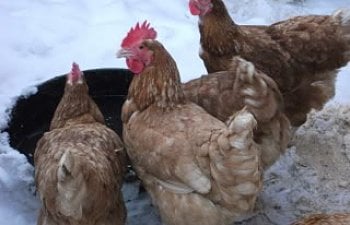
Chickens and other fowl have been critical to human survival, and have moved with humans to all reaches of the planet . That doesn't mean you can turn them loose in extreme weather, however, and as various breeds have been developed, you'll notice that you have to select and house according to weather. All of this would be easier if the temperature remained between room temperature and beach weather. We should be so lucky. . Some of us in winter climates buy our birds locally from lines of adapted stock.
At the same time there may be days when your birds cannot be let out. As I write, a savage storm is ripping through and though it is only -4C, the wind is whipping up granular snow that makes the situation more like a sand storm. I offered our hens the run but all twelve came to an immediate stop at the door so forceful that the back ones tipped the alpha out the door. She screamed and leapt back in, so I closed up the coop. Even with snow boards some of the crystals are whirling and I don't want hens with scalded corneas. So it's important to have enough floor and platform space for such days- we have 15-16 square feet per hen, and as a result we have an integrated flock which will not rip at each other or create conflict among the members.
We built tour first insulated coop between February and April of 2008. The in the fall of 2009 we insulated the barn in which it was located. During a December 2009 cold spell when the outdoor temperature was -14C and the chill factor was -23C, the main floor of the unheated barn was at -5C and the coop was at +2C, so the electric dog bowl in the coop didn't have to work hard. We were pleased- the insulation project was worth every penny. But of course you have to have rodents under control if you plan to insulate and out barn cats take care of that!
Before winter howls at your coop door, pay attention to drainage around the coop. If water does not flow easily away from it now, you will be haunted by a lack of action when the ground is frozen, or when you get rain or a thaw after a snow storm. Study the way water acts and be sure you can keep your run reasonably dry. Not everyone will roof a run and even if you do, rain ans snow can blow sideways and you will need sloping and trenching at the very least. Some owners have french drains and other types of tiles and these too have to be checked for flow. Nothing is more discouraging than a blockage in February in the northern hemisphere. And nothing smells quite as bad as wet poultry manure. Well, maybe a couple of things do, but you and your birds are better off high and dry!
In mid-November 2008 we were hit with a blizzard that left our roofed run filled with wet snow. This wouldn't have been so bad if we had not been hit the next day by a major snow event that dumped two feet of drifting snow, some of which careened through the hardware cloth in the run. The birds didn't like it, I didn't like it and it took hours to clear. So day, which is the last day of November before another weather event, we installed snow boards to control the snow drift on the bottom half of the run. It isn't pretty, but we're hoping it will solve the problem. I hadn't realized how spoiled I was when the ground stayed dry and the hens came into the coop without mud caked on their feet. I'll get pictures soon. We made the protective shields of 1/4" plywood sheathing to keep the weight down, and fastened them with 1" deck screws and washers for easy removal in the spring. The idea is to exclude the majority of the heavy snow but maintain the drainage and ventilation in the run.
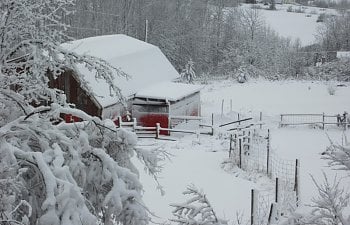
We're also experimenting with a strip of vinyl sheeting from the hardware store. We've sheathed the exit from the run with this material in an attempt to cut the severity of winter winds without decreasing the amount of light on that side. Without it the door is covered only in hardware cloth (1/2") which was great for summer ventilation.
After a blizzard December 8, 2008, a typical Nor'easter, there was only a skiff of snow in the run thanks to the snow boards and the interior temperature of the coop dipped to -1 degree Celsius when outside it was -11C with a wind chill factor of -23C. I guess the experiment worked, and the insulation paid off! In January 2009, with a mercury reading at -21 and wind chill of -41C, the interior temperature of the coop was a balmy -4C. I would never be in our climate without insulation. During a ten-day stretch of outdoor tems at -40 chill factors, the interior of the insulated coop never dropped below -6C. We had no instances of damaged combs.
The snow came up on the wide side of the run, we had about 15 cm (6 in) which drifted. Though we left the hardware cloth open at ground level for ventilation, we received only a skiff of snow from that opening, which gradually sealed and from the open top panels on the run. During the storm the birds used the outdoor platform only but this morning when it was over they were on the ground.
Chickens give off a lot of water and heat for their size. This requires intelligent intervention in regards to ventilation and water intake. The easiest thing you can do to reassure yourself is to place a thermometer in your coop. Over the span of a year you'll get a very good idea of the tolerances of your birds and to what degree their bodies adapt. Birds huddled and fluffed may be cold and trying to keep their feet warm, but if they're active and the feathers are sleek, chances are they're relishing the weather. If you spot excess condensation you may not have adequate air flow. We also like to avoid glass around animals so we designed this home-made window to address ventilation, snugging down on cold nights and the use of plexiglass to avoid accidents.
Better still, have a thermometer in the coop. The last time I checked at our hardware store, good ones were available from $1.88 to $19.99 Canadian. Avoid those with mercury or alcohol- it's one more thing to worry about and the spring-action ones are accurate indoors and out. After a season or two you'll understand the tolerances of your birds at various temperatures. You'll probably be delighted at how they cope with cold provided they have access to suitable housing, water and feed. Remember that if the water freezes you will impair their laying ability and metabolic function. If you switch to a heated waterer, leave the old one in the cop until you're sure every bird is drinking from the new one. As you can see the label didn't last long after getting wet. I took that out when I left.
This product comes with a protected cord and we were lucky to have a beam through which we could drill to pass the cord into a barn aisleway where we have an electrical outlet.
So how cold is too cold? Well, if you have a cold-adaptive breed like Chanteclers or Rhode Island Reds you'll probably find that not much discourages them. They'll exit the coop willingly given the choice and prefer to be outdoors as much as possible. This is to your advantage in terms of egg production as the increased light will keep them working. Things get tough if you get unexpected cold too soon, if the temperature gets below what your birds are adapted for, or if cold is prolonged. My hens flinched when the wind chill factor got to -23 C and would venture out only to grab a snack off the snow platform before jetting back inside. The coop temperature remained at -1C thanks to insulation and the heat give off by the birds and the actual temperature during the storm was -11C. This give me a guideline for future decisions about whether or not to open the pop door.
Then, just when you think you know what they can tolerate, the hens fool you. It was -11C on the morning of January 4, 2009, light snow, damp air and winds taking the chill factor down to about -15C. Oddly, the hens were pecking at the pop door to be let out. Interior of the barn was -5C and the coop sat at +1C. Hm. So I opened the pop door and watched them as I did my chores. I have a broody with a bare circle between her legs but she was one of the first to go outside. Over the next half hour the coop temp stabilized at 0C and the birds continued to go in and out. So, I left the pop door open and an hour and a half later they were still going in and out and playing in the snow, with some sunshine on the area. The barometer showed pressure going up slightly and the government weather website reporting rising temps. So it was the right decision for those hens on that day. I'm on the property most of the time in winter, so that's a factor, too. If you're leaving for work or a long errand, your decision may vary.
Needless energy can be costly and chickens are, after all, able to feather to various conditions. If you're getting a lot of condensation you may require more ventilation, and if you spot mold, regard it as a crisis, because it can make your birds very ill- you, too. Some of us keep a brooder lamp in the coop, offset from the roost for emergencies. I don;t use mine except to extend daylight, though I would consider it in an emergency. Then again, if there's an emergency the power might be off. Better to keep the birds well-feathered and let them adapt, is my current thinking. Plus, experience poultry owners recommend this.
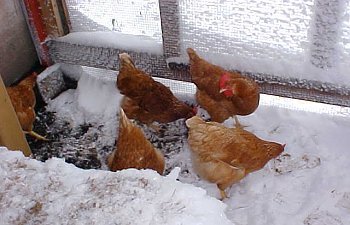
Some owners choose to insulate coops while others adapt their coops seasonally. Thoughtfully included, insulation can be of value in climates of either temperature extreme, keeping heat in, or out. It's a personal decision based on coop structure and size and whether you can expect to encounter hazards at this time of year. Choose thoughtfully and sheathe all insulation, chickens are notorious for eating deadly substances like styrofoam! Properly housed, chickens tolerate cold well, provided you're ready. You have to keep them out of drafts indoors and always ensure that they can get dry and warm if the weather turns nasty.During the blizzrd of Dec. 08, 2008 when the outside temperature was -11C, wind chill -23C, the interior of the coop never dropped below -1C. Of course the day after we installed our winter water heater for the hens.
Flooring is a big issue too. Cold floors are difficult for fowl, and require deep layers of bedding, where concrete and planked floors will remain warmer and require less bedding. Old-timers used the deep-litter method to insulate dirt floor and to reduce air space above in winter, going in the opposite direction in hot weather. Radiant heating is sometimes considered by owners but aside from loss during power failures the heat can significantly increase the ammount of ammonia and methane and correspondingly, the chance of fire. They may also promote louse, mite and tick growth too. If your structure is wood frame and has air flow underneath, consider insulating under the floor and sheath it, too. That way you have shade if your birds travel under there in summer but when winter winds blow, you can isolate that cold air from the feet of the birds. There is some connection between foot structure, blood flow and cold floors- suffice it to say the feet of chickens should be reasonably warm from feathering when they roost (min 4" base) and from bedding when they are on the floor.
Many owners find that their situation is best for temporary insulation, like straw bales around a coop or run. These can be removed and composted in summer and replaced the following winter. If you use straw or hay, though, be sure it can't get wet or you'll end up with spores and your birds may sicken. This is not a wise game to play because spore diseases are often fatal and can harm you, too.
Others install wind barriers, there's even a new woven plastic specifically for poultry runs. Don't ignore passive solar either, attention to window location can be very helpful in winter. You can reduce air volume indoors with bales of hay or straw, especially if you have few birds and think their mass will hot keep the air comfortable enough.
A severe winter storm can coat coops with ice, take out power and wreak havoc with animal husbandry. You can find coops buried in deep drifts for a short time and getting to your birds may be significantly delayed. For that reason, the use of larger feeders and waterers may become critical so that your birds can survive until you arrive. Be sure your roof will hold a snow load and is leak-proof. If designing a coop allow for enough slope that a snow load can melt or shift without hitting your birds. You also need to consider that rafters must be constructed so that a snow or ice load will not collapse into the structure, maimimg or killing birds. Remember that your safety matters too- you must be able to safely access your flock.
This is now our run looked after an unexpected November storm in 2008. Two days later we had another massive snowfall and the load was the wettest and therefore heaviest in 22 years. The snow boards have made a huge difference.
All living things require more food in cold weather. Be sure the feed dispensers are full or that the dishes always have a little left in them before the next refill. Your food bill will go down when it's warmer! If you are using a tractor, be sure it's brought indoors before snow or that the structure is located away from potential drifts or will not freeze into the landscape. A sad scenario is an unexpected snow storm in which you can't even get to them.
Providing enough air space in winter, free of ammonia, while keeping drafts from running through the flock is essential. It seems like a contradiction in behavior to provide both! What it means is that you have adequate air space without allowing the buildup of fumes.
Roosts can be widened to keep feet well-insulated under your birds 4" is a useful minimum, and you may find wider platforms are useful too. High and dry is the goal. Wet birds become miserably cold and at are risk of death in extreme cold. Some owners keep a poultry heating pad on hand for birds who are in trouble. Air vents should be placed high to circulate air without running frigid drafts over the chickens. Some owners find a need to protect combs with substances like Vaseline during bitter cold spells.
It's easy to forget that chickens need access to things for filing down their own beaks and nails if confined indoors. If you have your waterers suspended on cinder blocks, bricks or patio blocks they can rub their beaks against the blocks to keep them trimmed and they will climb aboard to scratch their nails down. The solution might be as simple as giving them a large rock of granite, sandstone or quartzite. Nails can get very sharp and I'd rather have the birds trim them than have to get out clippers. And a bird with an elongated or irregular beak may not be able to eat properly.
The deep-litter method will generate heat and insulate the base of your coop from drafts. When designing a coop for winter extremes, be sure to have adequate floor space to allow exercise and enough height to service the birds and allow them to avoid respiratory distress. Put extra bedding in your nesting boxes for the hens and to keep the eggs from freezing. Spot-cleaning of obvious droppings can substantially reduce ammonia. If not possible, cover old litter frequently with new. Consider mixing odor-control substances to the litter. Some great products include food-grade diatomaceous earth, Stall-Dri, hydrated lime and Stable Boy. However well you do, I bet you'll see condensation on the chicken side of your windows.
The Deep Litter Method
I'm not fond of the deep-litter method for my setup, though. I like to spot-clean daily and I don't need a huge base layer in my coop. If, like me, you have a well insulated floor (mine is planks over concrete) you may not wish to deal with deep litter and the huge cleanup after. The bonus is that you don't have to worry so much about ammonia. A discussion of spot-cleaning can be found here-
Spot-Cleaning
Whatever cleaning regimen you embrace, using a no-pest strip is a great idea. As parasites move indoors, you can knock them down by placing one high in the coop, out of the reach of the birds and not over food/water. No ticks, lice, fleas, flies...most feed supply stores, hardware stores, tack shops and agricultural supply outlets have them Some brands are Vapona, Black Flag, TSC. Home Hardware. You can always enclose one in a home-made cage too, if you don't have a place the birds can't reach. Best for coops of 1000 square feet and larger (10x10x10').
This is the time of year when your pop door will be the primary egress, and when outdoor roosts, platforms or bales of hay/straw can be used to give the animals a place to rise above show and worse, slushy runs. The birds always need a place to escape harsh winds and to fluff themselves dry. Extra roosts outdoors are a bonus. A roofed run is a great investment if you can manage it and will deter predators who are looking for easy pickings close to the boreal forest. Pay attention to enclosing the base of your run, too, using hardware cloth if possible with openings no greater than 1/2". Of course you won't be doing that now, the ground is frozen!
Speaking of predators, this is a time of year when rodents find coops particularly enticing. Let's hope the cats on the property are patrolling, and that your feed bins and dispensers are located where they are least likely to cause problems. While chickens can defend against mice, rats can rip at their vents and introduce infection, other disease and pests. Be wary, they are very clever.
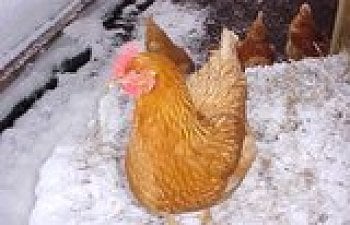
Speaking of runs, as the seasons change they can get muddy. Some use stepping stones to alleviate the situation, and filling in depressions with gravel or sand is worth considering to avoid standing water or ice.
Strategically-placed windows can be useful provided they are sealed well. The sun is low, and south and western exposures are the most useful. If your run is roofed with clear vinyl the birds will have access to more light for laying.
You might want to provide a sand box indoors so they can dust themselves adequately to keep mites, lice and ticks away. Some parasites move indoors at this time of year and you can prep dust baths and the litter with food-grade diatomaceous earth (DE), Dri-Kill, Sevin or other preparations. Some owners insulate for this season only, using bales of straw around the outside of the coop or to baffle wind at the base. Beware of mold and rodents and clear away promptly when the weather is warm enough.
Moulting can be expected at a year of age, and may coincide with cold weather, forcing you to decide when and for how long the chickens may be outside. Certain infestations and diseases can cause a moult too and roosters can sometimes leave hens bare, so the cause is an issue regardless of the temperature. Our forums can help with this. To keep the birds warm and to promote healthy feather growth consider adding suet or flock block. We use suet because we can easily get it at our local hardware store in the wild bird section. In September of 2009 as my hens went through their first adult molt, it is my belief that the suet greatly added to their dietary needs and in September 2009 they had a slow moult only and now have a dense feathergrowth with ample petticoats and pantaloons. We use the plain kind as well as whose with seed and berries added.
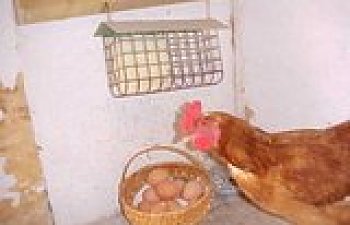
Of all your concerns, keeping the water liquid is the greatest. Some owners go several times a day to the coop with warm water, and those with electricity often invest in a metal double-sided waterer with a heater base. There are also newer plastic waterers with built-in heater. But don't combine an old-style plastic fountain with a metal heater base- it's a recipe for fire! Any heaters need to be well above bedding and could be places on a patio block resting on cinder blocks, or something similar. If you use concrete or a large rock indoors the birds also benefit from having a surface on which to sharpen their beaks in winter.
These photos show a double-walled/galvanized 3 gal waterer and a heater base designed with an element set to 50 Fahrenheit. Not yet installed, this unit will go on a patio block held above 3 cinder blocks in November. A spring will be placed where the electrical cord is in the coop and the remainder of the cord will exit through a hole in a beam to an outlet away from the birds.


There are many styles of water heaters. One of the best is a pet bowl already equipped with a plug that has a steel guard on the cord. Most hardware stores have de-icer elements that can be plugged in and submerged in a water dish or bucket. These come in many sizes and at least one has 2 bowls and is elevated. You have to be careful to elevate these devices away from bedding. Though they heat to about 50F only, they can become a fire hazard if the element is straining in prolonged cold weather.
You can also buy a water bucket with an embedded element. In the past people have gone to enormous lengths to make their own heaters. Some have used an electric bulb under a metal bucket. Others build an insulated compartment using a bulb and a nipple-type fountain extending out of the box. Whatever you decide, keep your building codes and safety guidelines in mind.
Some owners find that the use of a brooder lamp is sufficient even in a bitter cold spell because their birds have a seasonally-adapted feather coat, and others make use of ceramic heaters installed so that they can be aimed at the roost area. The use of heat might be as simple as using it only when birds seem to have gotten wet. As you become more experienced you'll know what is appropriate in your part of the world, and which breeds might need assistance. A word of caution. If you use a brooder lamp, even if the wattage is low, you should offset the lamp so that is is not directly over the birds and use a protective grille. The reason for this is to prevent burn, especially on the combs. Birds that are very cold may not be able to sense that they have entered a dangerous situation and the offset position, as shown below, will keep them from double trouble.
Birds can get very interested in all sorts of things, especially heaters. You have to think like a chicken, so if you use something emitting heat, is it situated so that a bird can't perch on it and get burned? You know they can get wedged in the oddest places, and if they decide to cook themselves....well, you get the idea. Heaters should not be necessary except in emergencies and if they are ever used you must five your birds at least 4" of grille on all sides. This grille should prevent birds from sticking a head or foot in, too. The risk of injury and death is high, and they are a primary cause of coop fires.
A hot box is a fascinating concept especially if you have young birds or if you experience cold which in uncharacteristically severe or prolonged. Basically it's a part of your coop heated by a brooder lamp or something similar. The birds can enter this enclosure by a small opening, and the surrounding structure holds in most of the heat. Cardboard is a good insulator and you can certainly build this kind of thing out of wood. Some people make part of their brooders with a hot box. Again, keeping the flammables away from the heat is vital. Oh, and since fingers get exceptionally sore if bumped in winter, wear lined gloves! If you've ever been pecked on the hand in winter you know how much more it hurts, then.
If you have plumbed water in your barn or coop, then heater tape is your friend. This picture shows a typical 1.5" PVC water pipe entering under a concrete floor and breaking off into 1/2" potable water piping. We're in the process of replacing the copper with plastic to avoid corrosion, and we'll apply heater tape along the length of the pipes, wrapping in fibreglass. In addition, we're building a box around the setup to protect it and to insulate against bitter winds, which blow in through a door alongside. Used as directed and in accordance with safety regs, heater tape can keep pipes flowing until the temperature plunges to -40 C. Heat tape is not mean for plastic drains or other non-water bearing conduit, however, don't be tempted. because of fire risk. Your local building codes and insurance companies may have conditions regarding the use of approved heater tapes and proper installation is critical.
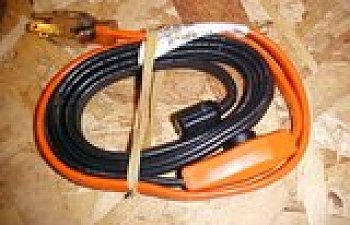

If you get this right, the coop will be a few degrees warmer than the outside, the air will be calm and fresh and the birds will be fine. In a prolonged cold spell there is the option of using a brooder lamp in the coop, as usual paying attention to fire safety. If the power is off, a huddle box is better.
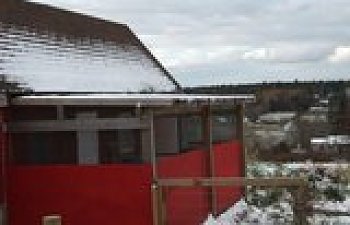
On November 7, 2009 we put up our snow boards before a Nor-Easter. Fortunately, little snow, but we're ready for some now.
A modification to a new section of our runs completed Nov. 2010
Already the birds prefer this end of the run. Good ventilation plus shelter above and on the sides.
